Seat Mii 2015 SOUND SYSTEM 1.X
Manufacturer: SEAT, Model Year: 2015, Model line: Mii, Model: Seat Mii 2015Pages: 36, PDF Size: 0.87 MB
Page 21 of 36
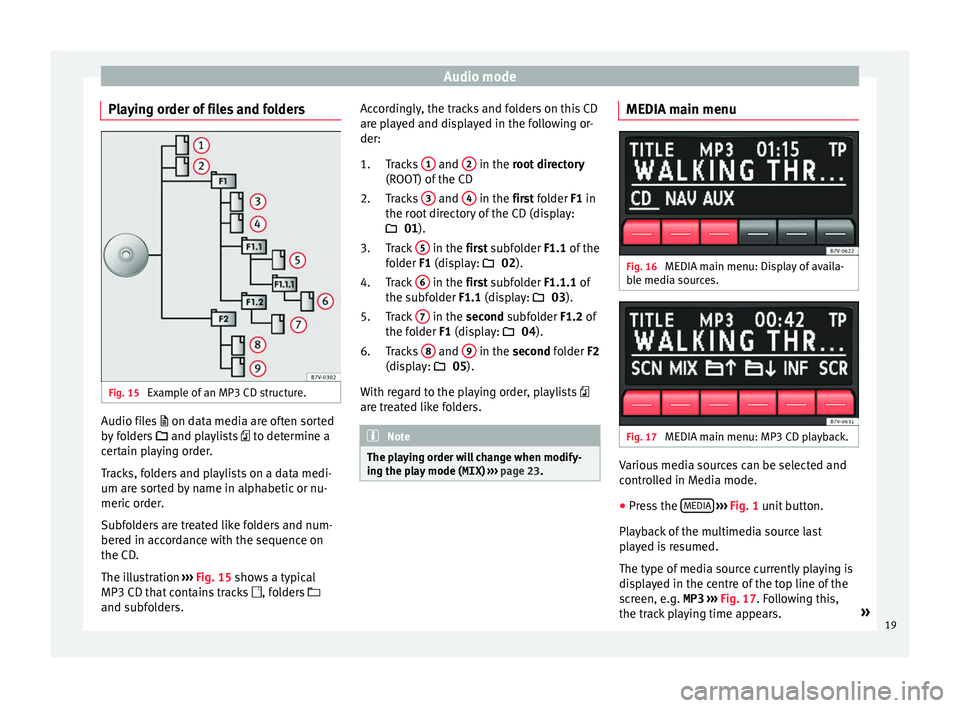
Audio mode
Playing order of files and folders Fig. 15
Example of an MP3 CD structure. Audio files
on dat
a medi a are often sorted
by folders and playlists to determine a
certain playing order.
Tracks, folders and playlists on a data medi-
um are sorted by name in alphabetic or nu-
meric order.
Subfolders are treated like folders and num-
bered in accordance with the sequence on
the CD.
The illustration ›››
Fig. 15 shows a typical
MP3 CD that contains tracks , folders
and subfolders. Accordingly, the tracks and folders on this CD
are pl
ayed and displayed in the following or-
der:
Tracks 1 and
2 in the r
oot directory
(ROO T) of
the CD
Tracks 3 and
4 in the fir
st folder F1 in
the r oot
directory of the CD (display:
01 ).
Track 5 in the fir
st subfolder F1.1 of the
f o
lder F1 (display: 02).
Track 6 in the fir
st subfolder F1.1.1 of
the s ubf
older F1.1 (display: 03).
Track 7 in the sec
ond subfolder F1.2 of
the f o
lder F1 (display: 04).
Tracks 8 and
9 in the sec
ond folder F2
(di s
play: 05).
With regard to the playing order, playlists
are treated like folders. Note
The playing order will change when modify-
ing the p l
ay mode ( MIX) ››› page 23. 1.
2.
3.
4.
5.
6.
MEDIA main menu Fig. 16
MEDIA main menu: Display of availa-
b l
e medi
a sources. Fig. 17
MEDIA main menu: MP3 CD playback. Various media sources can be selected and
c
ontr
o
lled in Media mode.
● Press the MEDIA
› ›
›
Fig. 1 unit button.
Playback of the multimedia source last
played is resumed.
The type of media source currently playing is
displayed in the centre of the top line of the
screen, e.g. MP3 ›››
Fig. 17. Following this,
the track playing time appears. »
19
Page 22 of 36
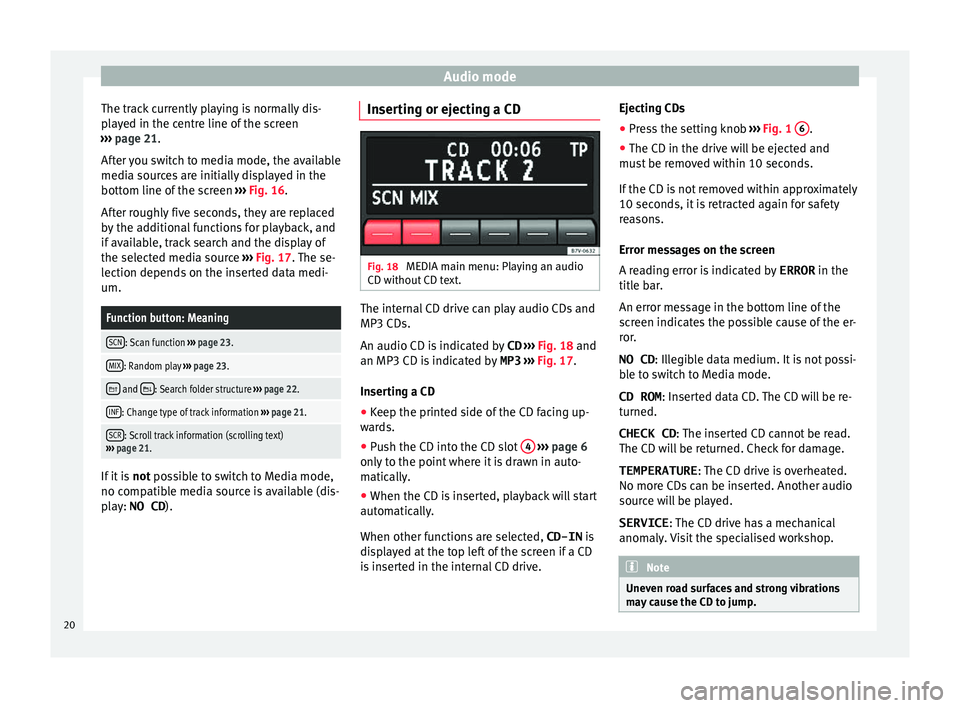
Audio mode
The track currently playing is normally dis-
p l
a
yed in the centre line of the screen
››› page 21.
After you switch to media mode, the available
media sources are initially displayed in the
bottom line of the screen ››› Fig. 16.
After roughly five seconds, they are replaced
by the additional functions for playback, and
if available, track search and the display of
the selected media source ››› Fig. 17. The se-
lection depends on the inserted data medi-
um.
Function button: Meaning
SCN: Scan function ››› page 23.
MIX: Random play ››› page 23.
and : Search folder structure
››› page 22.
INF: Change type of track information ››› page 21.
SCR: Scroll track information (scrolling text)
››› page 21. If it is
not po s
s
ible to switch to Media mode,
no compatible media source is available (dis-
play: NO CD ). Inserting or ejecting a CD
Fig. 18
MEDIA main menu: Playing an audio
CD w ithout
CD t
ext. The internal CD drive can play audio CDs and
MP3 CD
s.
An audio CD i s
indicated by CD ››› Fig. 18 and
an MP3 CD is indicated by MP3 ››› Fig. 17.
Inserting a CD
● Keep the printed side of the CD facing up-
ward
s.
● Push the CD into the CD slot 4
› ›
› p
age 6
only to the point where it is drawn in auto-
matically.
● When the CD is inserted, playback will start
automatic
ally.
When other functions are selected, CD-IN is
displayed at the top left of the screen if a CD
is inserted in the internal CD drive. Ejecting CDs
● Press the setting knob ›››
Fig. 1 6 .
● The CD in the drive will be ejected and
mu s
t
be removed within 10 seconds.
If the CD is not removed within approximately
10 seconds, it is retracted again for safety
reasons.
Error messages on the screen
A reading error is indicated by ERROR in the
title bar.
An error message in the bottom line of the
screen indicates the possible cause of the er-
ror.
NO CD : Illegible data medium. It is not possi-
ble to switch to Media mode.
CD ROM : Inserted data CD. The CD will be re-
turned.
CHECK CD: The inserted CD cannot be read.
The CD will be returned. Check for damage. TEMPERATURE : The CD drive is overheated.
No more CDs can be inserted. Another audio
source will be played.
SERVICE : The CD drive has a mechanical
anomaly. Visit the specialised workshop. Note
Uneven road surfaces and strong vibrations
ma y
cause the CD to jump.20
Page 23 of 36

Audio mode
Selecting a media source Fig. 19
Media selection menu: CD being
p l
a
yed from the internal CD drive. After you switch to Media mode, the available
medi
a sour
c
es are initially displayed in the
bottom line of the screen for several sec-
onds. The media source currently playing is
underlined ››› Fig. 19.
Opening the Media selection menu manually
and selecting a media source
● In Media mode, briefly press the MEDIA›››
Fig. 1 unit b
utton to display the Media se-
lection menu again.
● Activate the selected media source by
pre s
sing its function button.
● OR: Repeatedly press the MEDIA unit but-
t on a
s
often as required to switch between
the available media sources.
Function button: Media source
CD: Audio or MP3 CD in the internal CD drive
››› page 20.
NAV: Portable navigator ››› page 25
AUX: External audio source connected to AUX IN
››› page 23 multimedia socket. When a media source that has already been
pl
a
yed is selected again, playback is re-
sumed from the point that was last played
(except: AUX ››› page 23).
Track information display Fig. 20
Track information of a currently play-
in g audio CD w
ithout
CD text. Fig. 21
Track information of a currently play-
in g MP3 CD
. When an audio CD without CD text is playing,
only
TRACK and the tr
ack number, corre-
sponding to the playing order on the data
medium, are displayed in the centre line of
the screen ››› Fig. 20.
When playing audio files containing addition-
al track information (CD text , ID3 tag with
MP3 files), various types of track information
can be displayed.
Changing the display of track information
The type of track information selected is dis-
played on the left in the top line of the screen
(e.g. : TITLE ››› Fig. 21).
● Briefly press the INF function button to
c h
an
ge the type of track information dis-
played.
Display: Track information
TITLE : track name.» 21
Page 24 of 36
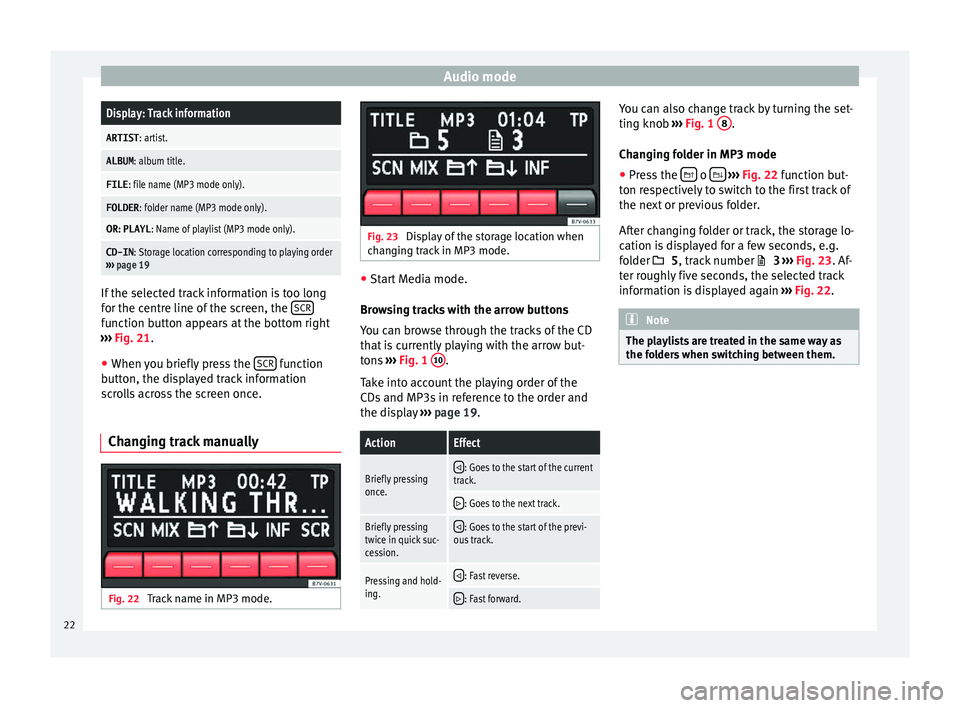
Audio modeDisplay: Track information
ARTIST
: artist.
ALBUM: album title.
FILE: file name (MP3 mode only).
FOLDER : folder name (MP3 mode only).
OR: PLAYL : Name of playlist (MP3 mode only).
CD-IN: Storage location corresponding to playing order
››› page 19 If the selected track information is too long
f
or the c
entr
e line of the screen, the SCRfunction button appears at the bottom right
› ›
›
Fig. 21.
● When you briefly press the SCR function
b utt
on, the di
splayed track information
scrolls across the screen once.
Changing track manually Fig. 22
Track name in MP3 mode. Fig. 23
Display of the storage location when
c h
an
ging track in MP3 mode. ●
Start Media mode.
Bro w
sing tracks with the arrow buttons
You can browse through the tracks of the CD
that is currently playing with the arrow but-
tons ››› Fig. 1 10 .
T ak
e int
o account the playing order of the
CDs and MP3s in reference to the order and
the display ››› page 19.
ActionEffect
Briefly pressing
once. : Goes to the start of the current
track.
: Goes to the next track.
Briefly pressing
twice in quick suc-
cession.
: Goes to the start of the previ-
ous track.
Pressing and hold-
ing. : Fast reverse.
: Fast forward. You can also change track by turning the set-
tin
g kno
b ›
›› Fig. 1 8 .
Ch an
gin
g folder in MP3 mode
● Press the o
› ››
Fig. 22
f
unction but-
ton respectively to switch to the first track of
the next or previous folder.
After changing folder or track, the storage lo-
cation is displayed for a few seconds, e.g.
folder 5, track number 3 ››› Fig. 23. Af-
ter roughly five seconds, the selected track
information is displayed again ››› Fig. 22. Note
The playlists are treated in the same way as
the fo l
ders when switching between them.22
Page 25 of 36

Audio mode
Changing playback mode (SCN and
MIX) Fig. 24
MEDIA main menu: random playback
a s
activ
e playback mode. Fig. 25
MEDIA main menu: random playback
fr om c
urr
ent folder only selected. Refer to the information on the playing order
of
fi
l
es and folders ›››
page 19.
Selecting play modes
The play modes that can be selected for the
current data medium are shown as function
buttons on the bottom left. ●
Pres
s a function button to start the corre-
sponding playback mode. The function but-
ton is underlined.
SCN Aut
omatic playback
: A
l
l tracks will play
for approximately 10 seconds. The scan func-
tion starts with the next track and ends auto-
matically when all tracks of the selected fold-
er or selected CD have been scanned.
MIX R
andom playback: The tracks play in
r andom or
der. Random playback remains ac-
tive for the corresponding media source until
it is closed for that source.
● Press the SCN or
MIX function button
ag ain t
o s
top the current playback mode of
the track currently playing.
The scan function can also be started and
stopped by pressing the setting button
››› Fig. 1 8 .
Diff er
ent
playback modes
Depending on the media source that is being
played (CD-DA or MP3) and whether playlists
are available, the different playback modes
indicated as follows can be selected:
Display: Effect
...CD : All the tracks on the current data medium will be
played in the selected playback mode.
...FOLDER : Only the tracks in the current folder are
played in the selected playback mode.
Display: Effect
...PLAYLIST : Only the tracks of the current playlist
will be played in the selected playback mode. To select a certain mode press the corre-
spondin
g f
unction button (SCAN or MIX) as
many times as required. The display will
change on the screen. For example: MIX
FOLDER > MIX CD > MIX PLAYLIST > (End of MIX
function).
Connecting an external audio source
to the A UX
-IN multimedia socket*. Depending on the vehicle, there is an AUX-IN
mu
ltimedi
a soc
ket on the front of the radio
››› Fig. 1 12 , the storage compartment on the
fr ont
p
assenger side, on the centre console
or on the armrest between the front seats.
The AUX-IN multimedia socket can only be
used with a 3.5 mm jack plug.
An external audio source connected to it can
only be played over the vehicle speakers, but
cannot be controlled via the radio system.
An external audio source connected to the
socket is indicated by AUX in the Media se-
lection menu.
If AUX is not displayed, AUX must be activa-
ted in the SETUP menu ›››
page 28. »
23
Page 26 of 36
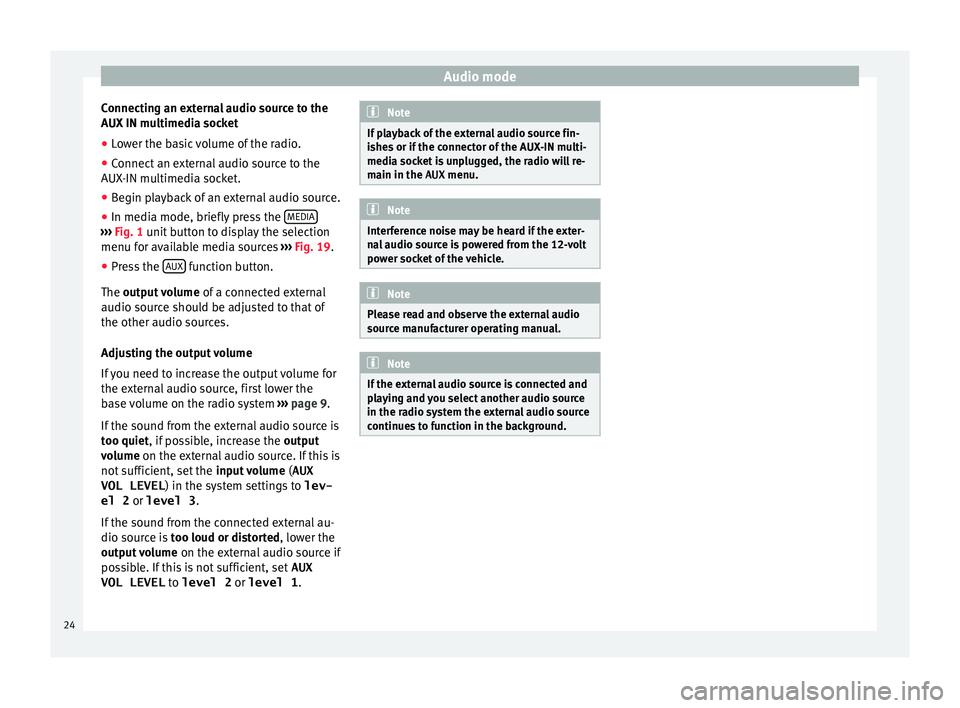
Audio mode
Connecting an external audio source to the
A UX
IN mu
ltimedia socket
● Lower the basic volume of the radio.
● Connect an external audio source to the
AUX-IN mu
ltimedia socket.
● Begin playback of an external audio source.
● In media mode, briefly press the MEDIA›››
Fig. 1 u nit button to display the selection
menu f or av
ailable media sources ››› Fig. 19.
● Press the AUX function button.
The outp ut
volume of a connected external
audio source should be adjusted to that of
the other audio sources.
Adjusting the output volume
If you need to increase the output volume for
the external audio source, first lower the
base volume on the radio system ››› page 9.
If the sound from the external audio source is
too quiet, if possible, increase the output
volume on the external audio source. If this is
not sufficient, set the input volume (AUX
VOL LEVEL ) in the system settings to lev-
el 2 or level 3 .
If the sound from the connected external au-
dio source is too loud or distorted, lower the
output volume on the external audio source if
possible. If this is not sufficient, set AUX
VOL LEVEL to level 2 or level 1. Note
If playback of the external audio source fin-
ishe s
or if the connector of the AUX-IN multi-
media socket is unplugged, the radio will re-
main in the AUX menu. Note
Interference noise may be heard if the exter-
na l
audio source is powered from the 12-volt
power socket of the vehicle. Note
Please read and observe the external audio
sourc e m
anufacturer operating manual. Note
If the external audio source is connected and
pl a
ying and you select another audio source
in the radio system the external audio source
continues to function in the background. 24
Page 27 of 36
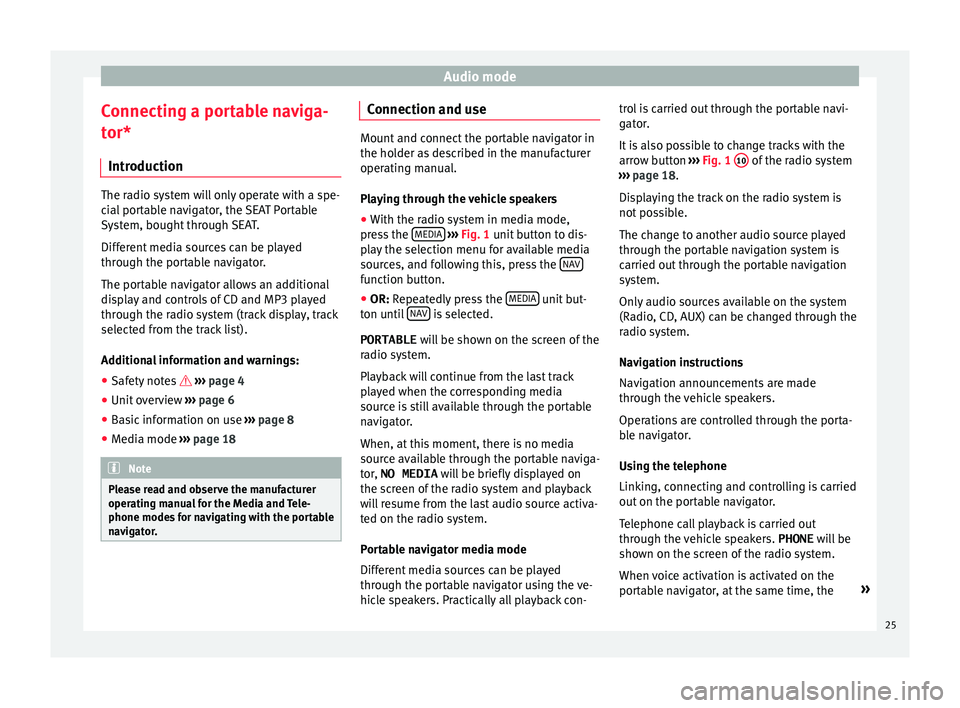
Audio mode
Connecting a portable naviga-
t or*
Intr oduction The radio system will only operate with a spe-
ci
al
portable navigator, the SEAT Portable
System, bought through SEAT.
Different media sources can be played
through the portable navigator.
The portable navigator allows an additional
display and controls of CD and MP3 played
through the radio system (track display, track
selected from the track list).
Additional information and warnings:
● Safety notes ››
›
page 4
● Unit overview ›››
page 6
● Basic information on use ›››
page 8
● Media mode ›››
page 18 Note
Please read and observe the manufacturer
operatin g m
anual for the Media and Tele-
phone modes for navigating with the portable
navigator. Connection and use
Mount and connect the portable navigator in
the hol
der a
s described in the manufacturer
operating manual.
Playing through the vehicle speakers
● With the radio system in media mode,
pres
s the MEDIA
››› Fig. 1 unit button to dis-
play the selection menu for available media
sources, and following this, press the NAV function button.
● OR: R epeatedly press the MEDIA unit but-
t on u
nti
l NAV is selected.
PORTABLE wi
l
l be shown on the screen of the
radio system.
Playback will continue from the last track
played when the corresponding media
source is still available through the portable
navigator.
When, at this moment, there is no media
source available through the portable naviga-
tor, NO MEDIA will be briefly displayed on
the screen of the radio system and playback
will resume from the last audio source activa-
ted on the radio system.
Portable navigator media mode
Different media sources can be played
through the portable navigator using the ve-
hicle speakers. Practically all playback con- trol is carried out through the portable navi-
gator
.
It is also possible to change tracks with the
arrow button ››› Fig. 1 10 of the radio system
› ›
›
page 18.
Displaying the track on the radio system is
not possible.
The change to another audio source played
through the portable navigation system is
carried out through the portable navigation
system.
Only audio sources available on the system
(Radio, CD, AUX) can be changed through the
radio system.
Navigation instructions
Navigation announcements are made
through the vehicle speakers.
Operations are controlled through the porta-
ble navigator.
Using the telephone
Linking, connecting and controlling is carried
out on the portable navigator.
Telephone call playback is carried out
through the vehicle speakers. PHONE will be
shown on the screen of the radio system.
When voice activation is activated on the
portable navigator, at the same time, the »
25
Page 28 of 36
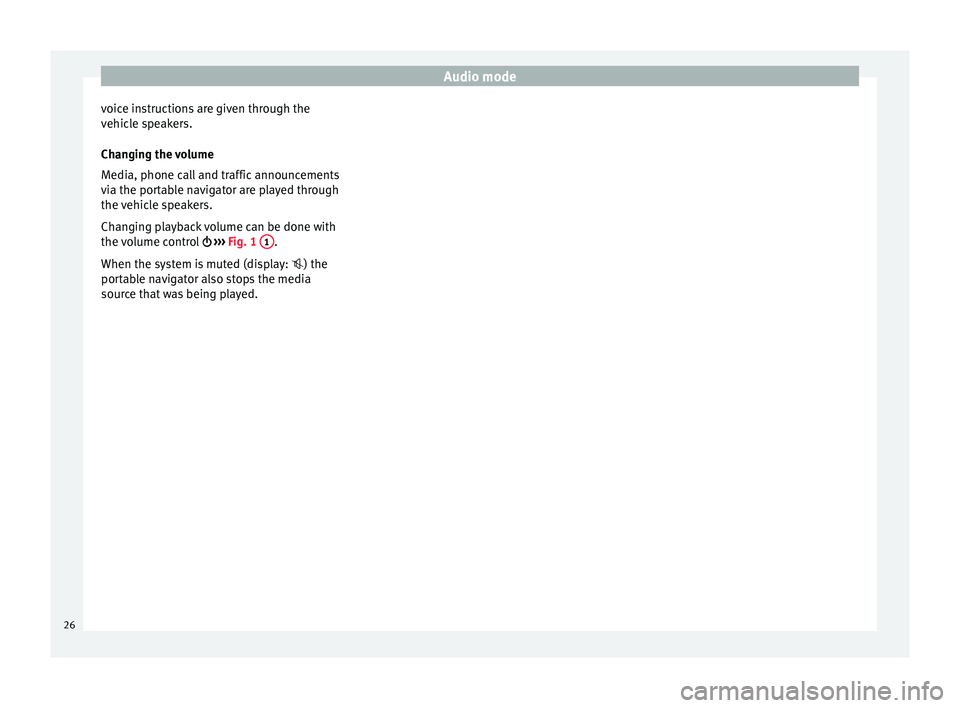
Audio mode
voice instructions are given through the
v ehic
l
e speakers.
Changing the volume
Media, phone call and traffic announcements
via the portable navigator are played through
the vehicle speakers.
Changing playback volume can be done with
the volume control ››› Fig. 1 1 .
When the sy s
t
em is muted (display: ) the
portable navigator also stops the media
source that was being played. 26
Page 29 of 36
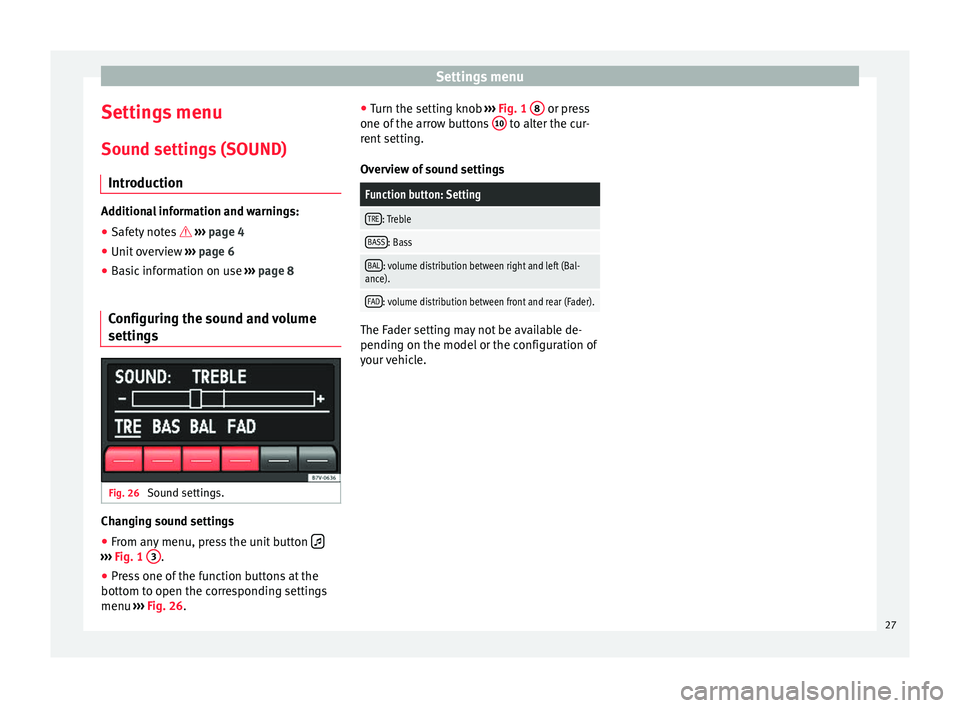
Settings menu
Settings menu Sou nd settin
g
s (SOUND)
Introduction Additional information and warnings:
● Safety notes ›››
page 4
● Unit overview ›››
page 6
● Basic information on use ›››
page 8
Configuring the sound and volume
setting s Fig. 26
Sound settings. Changing sound settings
● From any menu, press the unit button ›››
Fig. 1 3 .
● Press one of the function buttons at the
bott om t
o open the c
orresponding settings
menu ››› Fig. 26. ●
Turn the setting kno
b ››› Fig. 1 8 or press
one of the arr
o
w buttons 10 to alter the cur-
r ent
settin
g.
Overview of sound settings
Function button: Setting
TRE: Treble
BASS: Bass
BAL: volume distribution between right and left (Bal-
ance).
FAD: volume distribution between front and rear (Fader). The Fader setting may not be available de-
pendin
g on the model
or the c
onfiguration of
your vehicle. 27
Page 30 of 36
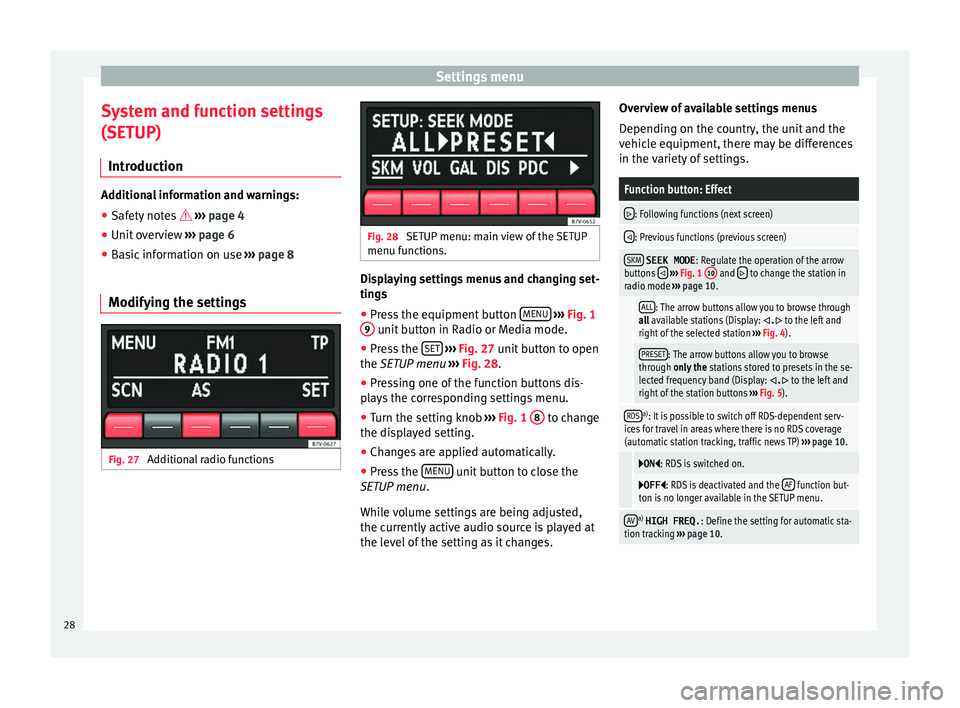
Settings menu
System and function settings
(S ETUP)
Intr oduction Additional information and warnings:
● Safety notes ››› page 4
● Unit overview ›››
page 6
● Basic information on use ›››
page 8
Modifying the settings Fig. 27
Additional radio functions Fig. 28
SETUP menu: main view of the SETUP
menu f u
nction
s. Displaying settings menus and changing set-
ting
s
● Pr
ess the equipment button MENU
› ›
› Fig. 1
9 unit button in Radio or Media mode.
● Press the S
ET
› ›
› Fig. 27
unit button to open
the SETUP menu ››› Fig. 28.
● Pressing one of the function buttons dis-
pla
ys the corresponding settings menu.
● Turn the setting knob ›››
Fig. 1 8 to change
the di s
p
layed setting.
● Changes are applied automatically.
● Press the MENU unit button to close the
S ETUP menu
.
Whi
le volume settings are being adjusted,
the currently active audio source is played at
the level of the setting as it changes. Overview of available settings menus
Depending on the c
ountry, the unit and the
vehicle equipment, there may be differences
in the variety of settings.
Function button: Effect
: Following functions (next screen)
: Previous functions (previous screen)
SKM SEEK MODE
: Regulate the operation of the arrow
buttons ››› Fig. 1 10 and to change the station in
radio mode ››› page 10.
ALL: The arrow buttons allow you to browse through
all available stations (Display: . to the left and
right of the selected station ››› Fig. 4).
PRESET: The arrow buttons allow you to browse
through only the stations stored to presets in the se-
lected frequency band (Display:
. to the left and
right of the station buttons ››› Fig. 5).
RDSa)
: It is possible to switch off RDS-dependent serv-
ices for travel in areas where there is no RDS coverage
(automatic station tracking, traffic news TP) ››› page 10.
ON: RDS is switched on.
OFF: RDS is deactivated and the
AF function but-
ton is no longer available in the SETUP menu.
AVa) HIGH FREQ. : Define the setting for automatic sta-
tion tracking ››› page 10. 28